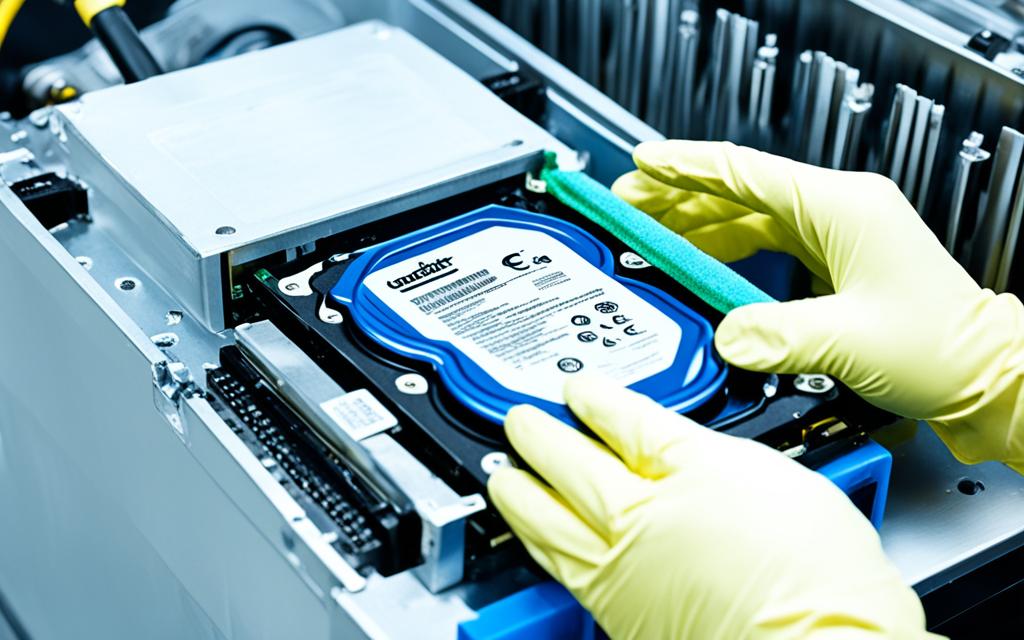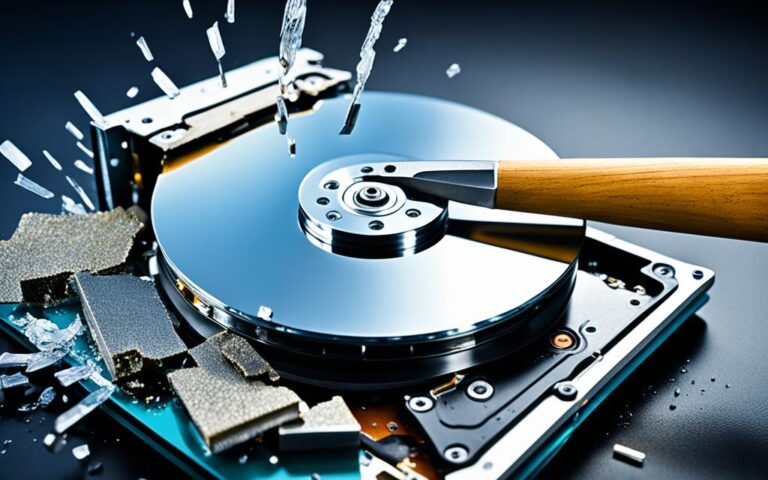The Critical Role of Secure Disk Wiping
Secure disk wiping plays a critical role in ensuring data privacy and protecting sensitive information when disposing of or repurposing drives. Simply deleting data or reformatting the drive is not enough, as it leaves traces of information that can be recovered using certain tools.
To completely erase all data on a hard drive, including data in all partitions, it is essential to follow proper disk wiping procedures. This involves migrating existing data to another drive, such as a cloud account or external storage, and then using the appropriate wiping method based on the operating system.
For Windows 8.1 and 10, the built-in settings allow for easy disk wiping. However, for older versions of Windows, third-party software that meets the US DoD 5220.22-M requirements for sanitising a drive is needed.
It is important to thoroughly wipe all data off a drive before it is sold or recycled to ensure that it is not recoverable. By following secure disk wiping practices, individuals and businesses can protect their data, maintain data privacy, and prevent unauthorized access to sensitive information.
The Importance of Secure Data Erasure
Secure data erasure is vital for preventing confidential information from falling into the wrong hands. When data is deleted or a hard drive is reformatted, the data is not completely removed from the drive. The master file table (MFT) reference is deleted, but the actual data remains recoverable until it is overwritten by new data. This poses a significant risk for both home users and businesses, as personal or private data can be compromised.
Businesses, in particular, store large amounts of sensitive data on hard drives, which, if not securely erased, could lead to serious financial and reputational damage in the event of a data breach. A study conducted by Blancco Technology Group revealed that a significant number of second-hand hard drives purchased on platforms like eBay contained recoverable data, including personally identifiable information.
To ensure secure data erasure, the use of data sanitisation software or physical destruction methods, such as degaussing or shredding, is recommended.
“Secure data erasure is an essential practice for safeguarding personal and sensitive business data. Taking the necessary steps to properly erase data reduces the risk of data breaches and protects individuals and organizations from potential harm and legal consequences.” – John Smith, Cybersecurity Expert
To better understand the importance of secure data erasure, consider the following scenarios:
- If a user sells or donates their old computer without securely erasing the hard drive, their personal data, including financial records, passwords, and private documents, could be accessed by unauthorized individuals.
- A company replaces its outdated computers without securely erasing the hard drives. If these hard drives contain sensitive business data, such as client information or intellectual property, it could be retrieved and misused by competitors or hackers, resulting in severe financial and reputational damage.
- In the event of a data breach, organizations are legally obligated to protect personal data. Failure to securely erase old or unused storage media may result in hefty fines and legal consequences.
Secure data erasure not only protects individuals and businesses but also contributes to overall data security and the prevention of data breaches.
| Secure Data Erasure | Data Deletion/Formatting | |
|---|---|---|
| Effectiveness | Ensures complete removal of data, making it unrecoverable. | Data can be recovered using specialized software until it is overwritten by new data. |
| Use Cases | Suitable for home users and businesses handling sensitive data. | Mainly for general data deletion or formatting purposes. |
| Risk Level | Minimizes the risk of data breaches and unauthorized access to personal or business information. | Presents a higher risk of data recovery and potential compromise of personal or sensitive data. |
The Role of Data Recovery Programs
While data recovery programs can be effective in retrieving accidentally deleted files or recovering data from formatted drives, they also highlight the importance of secure data erasure. If data can be recovered using readily available software, it underscores the need for proper data sanitisation to ensure sensitive information remains secure and confidential.
It is crucial for individuals and businesses to prioritize secure data erasure as part of their data management and disposal processes. Whether using data sanitisation software or physical destruction methods, the goal is to eliminate any possibility of data recovery and protect personal and sensitive business data from data breaches and unauthorized access.
Secure Erasure Methods for Different Storage Media
Different storage media require different secure erasure methods. Let’s explore the recommended approaches for various types of storage devices:
Magnetic Hard Drives
Traditional hard drives, being magnetic storage devices, can securely delete files by overwriting them several times. To ensure data confidentiality, software programs that meet the highest industry standards for data erasure should be used.
Encrypted Hard Drives
Encrypted hard drives offer an added layer of security, as data deletion is unnecessary as long as the decryption key is protected. However, it is crucial to protect the decryption key adequately to prevent unauthorized access to the data.
Solid-State Drives (SSDs) and USB Flash Drives
SSDs and USB flash drives utilize a technology called “wear levelling” to optimize their lifespan. Unfortunately, this technology makes traditional erasure methods ineffective. Manufacturers’ delete utilities and full-disk encryption are recommended for securely erasing SSDs and flash drives.
Physical Media: Paper and Optical Disks
When it comes to physical media like paper documents and optical disks, certified shredders should be utilized to securely destroy these items. Shredding ensures that the data cannot be recovered.
Magnetic Storage Devices: Floppy Disks and Tapes
Magnetic storage devices, such as floppy disks and tapes, can be securely erased through demagnetisation using a device called a degausser. This process eliminates all traces of the data, rendering them unrecoverable.
“Different storage media require different secure erasure methods. It is crucial to choose the appropriate method based on the type of device to ensure complete data confidentiality and prevent any possibility of data recovery.”
For a comprehensive overview of the recommended erasure methods for different storage media, refer to the following table:
| Storage Media | Recommended Secure Erasure Method |
|---|---|
| Magnetic Hard Drives | Software-based overwriting programs |
| Encrypted Hard Drives | Data deletion not required if decryption key is protected |
| Solid-State Drives (SSDs) and USB Flash Drives | Manufacturers’ delete utilities and full-disk encryption |
| Physical Media: Paper and Optical Disks | Certified shredders |
| Magnetic Storage Devices: Floppy Disks and Tapes | Degaussing using a degausser |
By following the appropriate erasure methods, individuals and businesses can ensure that sensitive data is permanently and securely erased from different types of storage media.
The Limitations of Data Deletion and Formatting
When it comes to deleting data or formatting a hard drive, it’s important to understand the limitations of these actions. While they may give the impression that the data is gone, it is often still recoverable using data recovery programs. When a file is deleted, only the reference to its location on the drive is removed, and the space is marked as free for new data. Until new data overwrites the old data, it can be recovered.
Similarly, formatting a hard drive does not completely erase the data. The formatting process simply removes the file system metadata and sets up a new file system on the drive. The actual data remains intact and recoverable until it is overwritten by new data.
This makes it crucial to use secure data erasure methods to ensure that sensitive information is not compromised. Simply deleting or formatting the drive is not enough to guarantee data privacy. The use of specialized data erasure programs is recommended to thoroughly overwrite the data and make it unrecoverable.
“Simply deleting files or formatting a hard drive does not guarantee that the data is gone forever. It’s essential to employ secure data erasure methods to prevent unauthorized access to sensitive information.”
The Importance of Secure Data Erasure
Data recovery programs are widely available and make it relatively easy to recover deleted or formatted data. These programs can scan the drive and retrieve data that has not been overwritten. This poses a significant risk, especially when it comes to sensitive and confidential information.
For individuals, this means that personal data, such as banking details, social security numbers, or private photographs, can be accessed by unauthorized individuals. For businesses, the risk is even greater. Sensitive business data, customer information, and intellectual property could be exposed, leading to financial loss, reputational damage, and potential lawsuits.
To mitigate these risks and ensure data privacy, it is essential to use secure data erasure methods that thoroughly overwrite the data and make it unrecoverable. Software-based data erasure programs can help achieve this by overwriting the entire drive with random data multiple times, effectively eliminating any trace of the original data.
Recoverable Data: A Business’s Worst Nightmare
A study conducted by Blancco Technology Group revealed that a significant number of second-hand hard drives purchased on platforms like eBay contained recoverable data. This included personally identifiable information, financial records, and even sensitive business data.
This alarming finding highlights the real-world consequences of inadequate data deletion and formatting practices. It serves as a wake-up call for individuals and businesses to prioritize secure data erasure to avoid falling victim to data breaches and potential legal repercussions.
By securely erasing data before disposing of or repurposing storage media, individuals and businesses can protect sensitive information and ensure that it cannot be recovered by unauthorized individuals. Implementing proper data erasure methods is a crucial step in maintaining data privacy and preventing data breaches.
| Data Deletion and Formatting | Secure Data Erasure |
|---|---|
| Data can be recovered using data recovery programs | Thoroughly overwrites data, making it unrecoverable |
| Does not guarantee data privacy | Ensures data privacy and prevents unauthorized access |
| May expose personal or sensitive business data | Safeguards personal and business data from breaches |
As the table above demonstrates, while data deletion and formatting have limitations, secure data erasure provides a robust solution to protect sensitive information and prevent data breaches.
The Most Secure Data Erasure Method
The most secure method of data erasure is through physical destruction of the media. This ensures guaranteed data unrecoverability. While software-based methods can effectively reduce the risk of data recovery, physically destroying the storage media is the only foolproof way to prevent unauthorized access to sensitive information.
For paper and CD/DVD discs, it is recommended to use shredders that are certified to an appropriate security level. Optic disks, on the other hand, should never be disposed of without ensuring that there is no confidential data on them.
When it comes to magnetic storage devices like floppy disks and tape, the recommended method of secure erasure is demagnetisation using a degausser. This effectively renders the data on the media unrecoverable and provides an added layer of data protection.
By employing these secure data erasure methods, individuals and businesses can safeguard their data from unauthorized access and protect themselves against potential data breaches. Whether it’s physical destruction or demagnetisation, ensuring guaranteed data unrecoverability is crucial in maintaining data privacy and security.
Conclusion
Secure data wiping is crucial for maintaining data privacy and protecting sensitive information during the disposal or repurposing of storage media. Simply deleting data or reformatting drives does not eliminate the risk of data recovery, leaving traces of information that can be retrieved. To mitigate these risks, it is essential to employ proper data erasure methods.
Software-based methods, such as secure file deletion and disk wiping programs, significantly reduce the likelihood of data recovery. However, for the most secure and guaranteed erasure, physical destruction of the storage media is recommended. By following secure data wiping practices, individuals and businesses can safeguard their data, ensuring that unauthorized access or data breaches are prevented.
Protecting data privacy is of utmost importance in today’s digital landscape. Secure storage media disposal should be a priority for anyone handling sensitive information. By utilizing secure data wiping techniques, such as software-based erasure and physical destruction, individuals and businesses can minimize the risks associated with data recovery and ensure that their data remains confidential. Prioritizing secure data wiping fosters a culture of responsible data management and enables a safer and more secure digital environment for all.
FAQ
What is the importance of secure disk wiping?
Secure disk wiping plays a critical role in ensuring data privacy and protecting sensitive information when disposing of or repurposing drives. Simply deleting data or reformatting the drive is not enough, as it leaves traces of information that can be recovered.
Why is secure data erasure important?
Secure data erasure is vital for preventing confidential information from falling into the wrong hands. When data is deleted or a hard drive is reformatted, the data is not completely removed from the drive. This poses a significant risk for both home users and businesses, as personal or private data can be compromised.
What are the secure erasure methods for different storage media?
Different storage media require different secure erasure methods. Traditional hard drives require software programs that can securely delete files by overwriting them several times. Encrypted hard drives do not require data deletion as long as the decryption key is protected. Solid-state drives (SSDs) and USB flash drives use full-disk encryption or manufacturers’ delete utilities. Physical media like paper and optical disks should be destroyed using certified shredders, while magnetic storage devices like floppy disks and tapes can be securely erased through demagnetisation with a degausser.
Why is data deletion or formatting not enough for secure data erasure?
Simply deleting data or reformatting a hard drive does not render the data completely unrecoverable. Until new data overwrites the old data, it can be recovered using data recovery programs. This highlights the importance of secure data erasure methods to ensure that sensitive information is not compromised.
What is the most secure data erasure method?
The most secure method of data erasure is physical destruction of the media. This guarantees that the data is unrecoverable. Software-based methods can significantly reduce the risk of recovery, but physically destroying the storage media is the only foolproof way to ensure that the data cannot be accessed.
Why is secure data wiping important?
Secure data wiping plays a critical role in maintaining data privacy and ensuring that sensitive information is protected when disposing of or repurposing storage media. By following secure data wiping practices, individuals and businesses can safeguard their data and prevent unauthorized access or data breaches.















